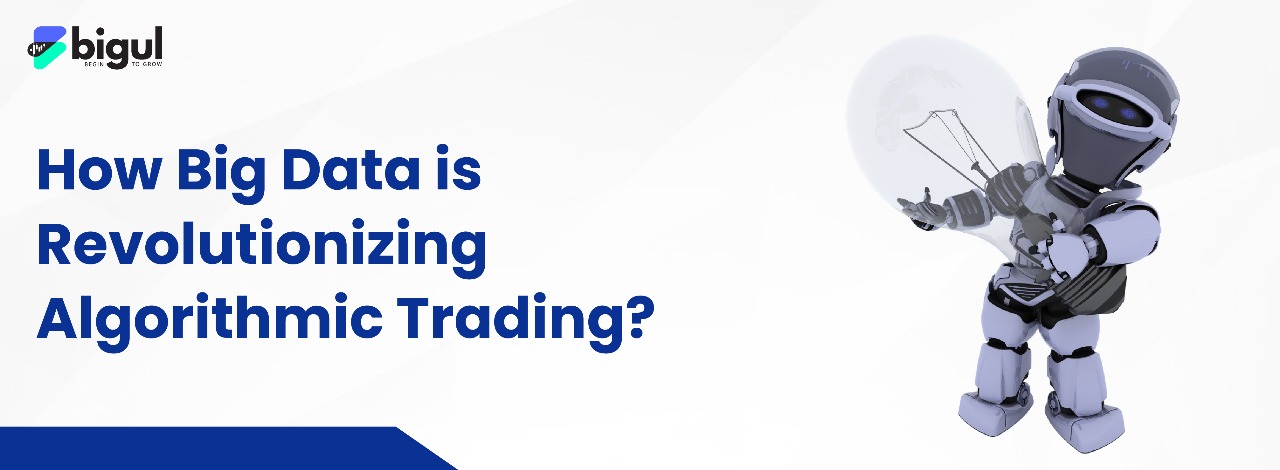One of the most significant branches of quantitative finance is algorithmic trading, wherein Big Data analytics could really turn things upside down. Financial markets used to rely on traditional sources of information, such as technical and fundamental analysis to make trading decisions.
The coming together of Big Data and algorithmic trading has led to an arena where there are opportunities for traders to access a constantly widening repository of data—ranging from past market history to lesser sources such as sentiment on social media, satellite photos, and economic indicators in real-time.
This paper aims to provide a comprehensive overview of Big Data's symbiotic relationship with algorithmic trading. Through a critical examination of practice and empirical research, we aim to discuss how Big Data has transformed trading strategy, increased market efficiency, and opened doors for the next wave of financial decision-making.
Also Read | Algo trading: How It Works, How To Start, And What Are The Pros and cons of Algo Trading
What Is Algorithmic Trading?
Algorithmic trading refers to the use of computer algorithms to automate the execution of trades in financial markets, driven by predefined rules, mathematical models, and real-time data inputs, with minimal human intervention, to optimise trade execution, reduce trading costs, and improve efficiency by analysing vast amounts of data, identifying patterns, predicting market trends, and generating trading signals.
Key Strategies of Algorithmic Trading
1. Trend Following Algorithms
Trend following is perhaps the best-known method among algorithmic trading, in which an algorithm identifies trends in the markets and acts on them. The simple theory behind this concept is that assets, rising on the stock exchange platform, will keep increasing in their price, while the other assets that have already been in a downtrend will continue falling."
These algorithms monitor past price and volume data in order to predict future price action.
As soon as the trend is identified, buy or sell orders are placed accordingly in a bid to gain from the ongoing price action. How well this method works depends upon whether the algorithm will catch on to a trend quickly and enter before the market is heavily saturated.
2. Algorithms for Mean Reversion
The mean-reversion approach is based, as suggested by its name, on the assumption that an asset should come back to its historical mean level since it diverged from it significantly. These algorithms are such a kind of programs that are looking for situations where an asset's price diverges from the mean and make transactions according to the belief that the price will somehow tend to revert to the mean.
The algorithm may sell when prices are too high or purchase when prices are too low in comparison to historical norms. This strategy thrives in volatile market environments and can prove most useful in markets that tend to display consistent cyclical patterns.
3. Statistical Arbitrage
Statistical arbitrage is the application of mathematical models to spot price inefficiencies between two or more correlated assets. Statistical arbitrage strategies rely on statistical measures, like the correlation coefficient or cointegration, to forecast when the prices of these assets will converge or diverge. Thanks to the infusion of big-data technologies, the algorithms have now become enabled to take into consideration a biger set of variables, including macroeconomic data, company earnings, and live news. A larger set of data provides a more accurate forecast and more opportunities for arbitrage.
4. High-Frequency Trading (HFT)
High-frequency trading (HFT) means putting a huge number of trades in very short durations, usually milliseconds or microseconds.
The purpose of HFT is to take advantage of minor price differences that persist for only a moment. Such strategies are based on high-speed data feeds and low-latency execution systems to acquire a competitive advantage.
Big data has a central importance in HFT, as algorithms can use real-time analysis of market movements to act on transitory opportunities. As HFT develops further, algorithms are beginning to use broader sources of data.
5. Machine Learning and AI-Driven Algorithms
Machine learning (ML) and artificial intelligence (AI) have taken a center role in algorithmic trading nowadays. Such algorithms use historical data to pick up patterns and refine their methods with time and increase the probability of accurate forecasting of market fluctuations. Of the common techniques within ML-based trading techniques, these include supervised learning, unsupervised learning, and reinforcement learning. Machine learning enables the algorithms to learn on-the-fly based on real-time data from the market, which helps to enhance their decision-making continuously. This approach can be extremely useful in volatile markets wherein human ingenuity and classical models may not be sufficient enough to capture the complexities of such great data.
Big data analytics underlies machine learning algorithm training in that it provides the algorithms large volumes of data, which algorithms utilize to train patterns and accurately predict. When non-traditional data sources such as geospatial, web-based behavioral, and sentiment data are fused into algorithms drawn from artificial intelligence, the AI-based algorithms adjust their predictions accordingly and provide more improved overall performance in trading.
Using Big Data In Algorithmic Trading
In algorithmic trading, big data has become of substantial importance in complimenting the overall effectiveness of trading strategies. Massive volumes of structured and unstructured data are processed and analyzed so as to make trading decisions that a bit more rational and informed. Some of the key aspects of where big data is applied include:
1. Big data sources.
Big data utilised by algorithmic trading relies on both traditional market data and other alternative sources.
Market Data: Historical prices, volumes of trades, and market liquidity are very crucial when it comes to the tracking of trends and patterns in the market.
Alternative Data: Social media sentiment, weather, satellite imaging, and consumer behavior data, belong to that part of algorithmic trading just before unknown territories. This type of big data gives real-time inputs into drivers steering asset prices, which was not part of traditional market data.
By bringing together a subset of these data feeds, algorithms can process and act upon far more variables, allowing more accurate predictions and a much more efficient trading strategy.
2. Data Analytics and Processing
Big data requires advanced auxiliary data processing centers for it to be understood. The processing of huge data streams is done in real time for the banks using the technologies such as Apache Hadoop, Apache Spark, and Apache Kafka. Such processes help proper storage, retrieval, and analysis of big data using high-frequency trades and big-sized market analysis.
In big data analytics, the algorithms are able to properly conclude from their analysis of the structured and unstructured data. Data from news wires, company statements, and social media can be analyzed using data-gathering technologies like Natural Language Processing (NLP) to gain insight into possible pricing movements and general market sentiments.
3. Machine Learning Models
Machine learning techniques augment algorithmic trading through enabling algorithms to learn and adapt from previous trade decisions. Supervised learning is where models are trained on labeled data sets in order to predict future events, and reinforcement learning enables algorithms to alter strategy based on continuous feedback of trading outcomes.
With model training on large sets of price action, economic data, and social media sentiment, the algorithms tune their predictions and learn to adapt to evolving market conditions. They improve the ability to forecast short-term price action and execute trades accurately.
The Impact of Big Data on Market Efficiency
Big-data-driven algorithmic trading has immensely increased market efficiency with faster speed of trade execution, improved liquidity, and minimized transaction costs.
1. Faster Price Discovery
With real-time processing of data, algorithms can react almost immediately to new data so that prices are always up to date and adjusted to current market conditions. This real-time price discovery reduces opportunities for arbitrage and allows for more efficient overall markets.
2. Increased Liquidity
Big data allows for algorithms to handle large quantities of trades with minimal market impact. This increases market liquidity and helps to operate more smoothly in markets that would otherwise be illiquid, particularly in lower-liquidity markets or assets.
3. Reduced Transaction Costs
By automating transactions and implementing them in the most favorable circumstances, algorithmic trading minimises transaction costs. Algorithms can dismember large transactions into smaller transactions so that they do not have a noticeable impact on market prices, and the cost of trading is low.
Updates In The Arena Of Algorithmic Trading
1. Quantum Computing
Quantum computing will help algorithms to analyse information faster. Quantum computers allow high-frequency traders to analyse many options simultaneously while simulating complex market scenarios.
2. Blockchain Integration
Today, it is a common practice to incorporate blockchain technology in algorithmic trading systems. The essence of blockchain technology is set on executing trades through smart contracts, an odd but secure method. The reasonable exploration of ways in which engagement accompanied by quality could support faster settlements, improved transparency, and reduced operational costs.
3. Regulation and Oversight
As algorithmic trading continues to rise across the world, governments are stepping in to make sure that these trading platforms are being utilised within legal and moral boundaries. MiFID II (Markets in Financial Instruments Directive) and Dodd-Frank are only a couple of such pieces of legislation that are determined to raise transparency and equity in algorithmic trading.
Conclusion
The impact of big data in algorithmic trading is modifying their quality due to more rapid, accurate, and efficient algorithms. Alternately, machine learning, real-time processing, and alternative data are taking algorithmic trading to another level for more informed trading decisions. Algorithmic trading is thus entering a bright future, unlocking further potential with tools such as quantum computing and blockchain.
Also Read:
- Is Algorithmic Trading Safe for Investors
- Top Algo Trading Software for Beginners
- Start Algo Trading Using Python | Complete Guide by Bigul
- Mastering Algo Trading: Strategies for Success in Automated Trading









.jpg)
.jpg)
